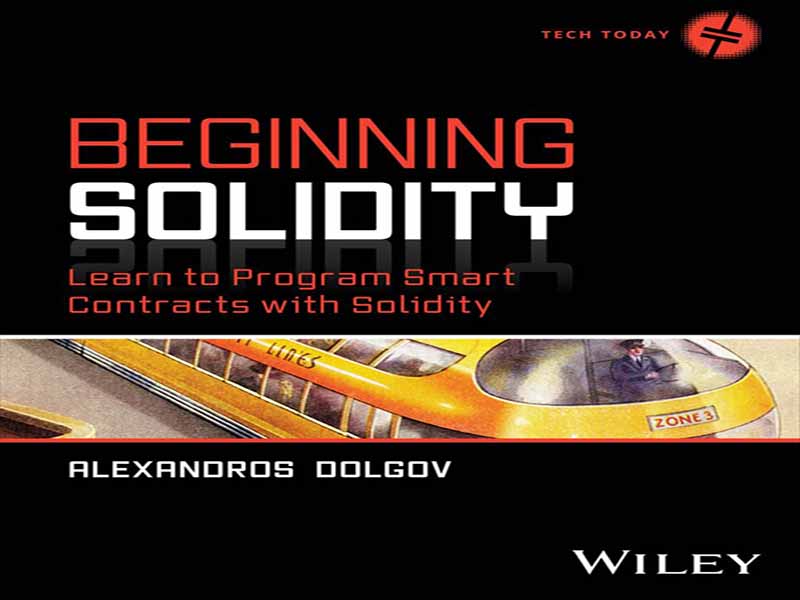- عنوان کتاب: BEGINNING Solidity – LEARN TO PROGRAM SMART CONTRACTS WITH SOLIDITY
- نویسنده: Alexandros Dolgov
- حوزه: برنامه نویسی Solidity
- سال انتشار: 2025
- تعداد صفحه: 983
- زبان اصلی: انگلیسی
- نوع فایل: pdf
- حجم فایل: 20.7 مگابایت
این کتاب در اصل درباره یادگیری برنامهنویسی سالیدیتی، بهویژه روی بلاکچین اتریوم، با استفاده از چارچوب توسعه فاندری است. هدف، ایجاد منبعی برای برنامهنویسان باتجربه، مشتاق و مبتدی است تا اولین گامهای خود را در تسلط بر زبان برنامهنویسی سالیدیتی بردارند. فاندری به عنوان یک چارچوب به جای هاردهت و ترافل انتخاب شد زیرا فاندری در مقایسه با آن چارچوبهای توسعه، چارچوبی سرراست است. این چارچوب با زبان راست نوشته شده است و از نظر سرعت، عملکرد و سبک بودن برتری دارد. علاوه بر این، هنگام استفاده از هاردهت و ترافل، برای اجرای تستها و استقرارها باید با زبان برنامهنویسی دیگری، جاوا اسکریپت، آشنا باشید. در فاندری، همه این کارها فقط از طریق سالیدیتی و کدهای تقلب انجام میشود. فاندری برای کار به هیچ تنظیمات یا افزونه اضافی نیاز ندارد. فاندری با مجموعه ابزارهای بومی خود، مانند آنویل، که گره توسعه محلی اتریوم فاندری است و به شبیهسازی محیط بلاکچین اتریوم برای آزمایش و اشکالزدایی کمک میکند، ارائه میشود. یکی دیگر از ابزارهای بومی Foundry، Cast است که ابزاری است که از خط فرمان برای تعامل با شبکه اتریوم استفاده میکند و به فرمان خود اجازه میدهد تا با قراردادهای هوشمند مختلفی که در شبکه اتریوم مستقر شدهاند، تعامل داشته باشد. تعاملات اضافی با استفاده از Cast شامل ارسال تراکنشها و بازیابی دادههای بلاکچین است. آخرین جزء در مجموعه ابزارهای Foundry، Forge نام دارد. Forge ابزار توسعه قرارداد هوشمند Foundry است که امکان کامپایل، آزمایش و استقرار قراردادهای هوشمند را در Solidity بدون نیاز به استفاده از جاوا اسکریپت یا هر زبان دیگری فراهم میکند. هنگام برنامهریزی و نوشتن این کتاب، هدف من فراتر رفتن از آموزش صرف Solidity به صورت جداگانه بود. میخواستم مطمئن شوم که شما درک درستی از زمینه گستردهتر، از جمله پیامدها، پتانسیلها و تاریخچه این فناوری، به دست خواهید آورد. برای انجام این کار، کتاب را با پوشش موضوعاتی آغاز میکنم که اگرچه مستقیماً بر Solidity متمرکز نیستند، اما برای ایجاد درک کاملی از اتریوم و فناوری زیربنایی آن بسیار مهم هستند. فصلهای بعدی ابزارها و تکنیکهای خاصی را که برای شروع تسلط بر برنامهنویسی Solidity باید بدانید، پوشش میدهند. فصل اول به طور خلاصه تاریخچه پول و چگونگی درک و استفاده از اشکال مختلف پول توسط فرهنگهایی که هر نوع خاص پول را به وجود آوردهاند، مورد بحث قرار میدهد. این فصل، مروری مختصر از مبادله کالا به کالا و پول اولیه تا ارزهای دیجیتال امروزی ارائه میدهد و در عین حال نمونههایی از موارد استفاده مختلف از فناوری اتریوم را ارائه میدهد. فصل دوم، بدون پرداختن عمیق به معماری اتریوم، به طور خلاصه به آن میپردازد. این فصل اصول اولیه معماری اتریوم، نحوه عملکرد آن و دلیل اتخاذ برخی تصمیمات در مورد معماری آن به روشی که اتخاذ شدهاند را پوشش میدهد. همچنین، تحولات آینده اتریوم را بررسی میکند تا به شما کمک کند تا از وضعیت اتریوم و تحولات برنامهریزی شده آینده این فناوری مطلع باشید. فصل سوم، مقدمه و آموزش نصب و استفاده از متامسک، یکی از شناختهشدهترین کیف پولها در صنعت ارزهای دیجیتال است. این فصل، استفاده از فاستهای اتریوم برای دریافت اتر شبکه آزمایشی – نسخه جعلی ارز دیجیتال اتریوم که برای آزمایش استفاده میشود – و نحوه استفاده از کاوشگرهای بلوک برای مشاهده و تجزیه و تحلیل تراکنشهایی که در بلاکچین اتریوم اتفاق میافتد را پوشش میدهد. این فصل همچنین توضیح میدهد که چگونه توسعهدهندگان میتوانند قراردادهای هوشمندی را که با آنها تعامل دارند درک کنند و اطلاعات ارائه شده توسط کاوشگرهای بلوک را تفسیر کنند. همچنین شامل نکاتی در مورد جلوگیری از کلاهبرداری توسط افراد مخرب و مروری بر کیف پولهای مختلف موجود در ارزهای دیجیتال است. این فصل به توسعهدهندگان درک تفاوتها، مزایا و معایب هر نوع کیف پول را میدهد. فصل چهارم کتاب، Remix را معرفی میکند، یک محیط توسعه یکپارچه (IDE) بومی آنلاین – و اکنون به صورت آفلاین نیز در دسترس است – اتریوم که توسعهدهندگان و توسعهدهندگان مشتاق میتوانند از آن برای آزمایش سریع قراردادهای هوشمند خود یا برداشتن اولین گامهای خود در برنامهنویسی Solidity استفاده کنند. در فصل چهارم، شما اولین قرارداد هوشمند ساده خود را خواهید ساخت. در فصل پنجم، در حالی که هنوز از ویژگیهای جدیدی که Remix IDE ارائه میدهد استفاده میکنید و آنها را بررسی میکنید، شروع به ساخت قراردادهای هوشمند پیچیدهتر خواهید کرد، در این مورد، یک قرارداد مدیریت باغ وحش که حیوانات یک باغ وحش کوچک و همچنین تعداد بازدیدکنندگان از باغ وحش را مدیریت میکند. فصل ششم شامل نصب یک IDE حرفهای به نام Visual Studio Code (VS Code) است که برنامهنویسان فعلی آن را میشناسند، اما برنامهنویسان مشتاق Solidity ممکن است ندانند. همچنین نصب چارچوب Foundry را در خود VS Code پوشش میدهد. فصل هفتم کتاب دوباره به بررسی قرارداد مدیریت باغ وحش میپردازد، این بار در محیط VS Code و Foundry. هدف اصلی، بررسی چارچوب Foundry و نمایش ابزارهای آن، نحوه استفاده از ابزارهای Foundry، نحوه کامپایل قرارداد در چارچوب و نحوه استقرار قرارداد هم در بلاکچین یکپارچه محلی Anvil که همراه با Foundry است و هم در بلاکچین اتریوم است. همچنین نحوه … را پوشش میدهد…
AT ITS CORE, THIS BOOK IS ABOUT LEARNING Solidity programming, specifically on the Ethereum blockchain, using the Foundry development framework. The goal is to create a resource for seasoned, aspiring, and beginning programmers to make their first steps in mastering the Solidity programming language. Foundry as a framework was selected over Hardhat and Truffle because Foundry is a straightforward framework when compared to those development frameworks. It is written in Rust, and it excels in speed, performance, and being lightweight. Additionally, when using Hardhat and Truffle, you need to be familiar with another programming language, JavaScript, to run tests and deployments. In Foundry, all this is done only through Solidity and cheat codes. The Foundry does not need any additional setup or plugins to work. Foundry comes with its own native set of tools, such as Anvil, which is Foundry’s own local Ethereum development node that helps simulate Ethereum’s blockchain environment for testing and debugging. Another tool native to Foundry is Cast, which is a tool that uses the command line to interact with the Ethereum network and allows its command to interact with the different smart contracts that have been deployed on Ethereum’s network. Additional interactions using Cast include sending transactions and retrieving blockchain data. The final component in Foundry’s arsenal of tools is called the Forge. Forge is Foundry’s smart contract development tool, which allows for smart contract compilation, testing, and deployment in Solidity without the need to use JavaScript or any other language. When planning and writing this book, my aim was to go beyond simply teaching Solidity in isolation. I wanted to ensure you will gain an understanding of the broader context, including the implications, potential, and history of this technology. To do that, I begin the book by covering topics that, while not directly focused on Solidity, are crucial for building a well-rounded understanding of Ethereum and the underlying technology. Later chapters cover specific tools and techniques you need to know to begin to master Solidity programming. The first chapter briefly discusses the history of money and how different forms of money have been perceived and used by the cultures that gave birth to each specific type of money. It provides brief overviews from barter and primitive money to today’s cryptocurrencies while giving different use case examples of Ethereum’s technology. The second chapter goes briefly through Ethereum’s architecture without doing a deep dive into it. It covers the basics of Ethereum’s architecture, how it works, and why some decisions about its architecture were taken in the way they were taken. It also explores Ethereum’s future developments to help you stay up-to-date with the state of Ethereum and with the planned future developments of the technology. The third chapter is an introduction and tutorial on installing and using MetaMask, one of the most well-known wallets in the cryptocurrency industry. It covers using Ethereum faucets to get testnet ether—a fake version of Ethereum’s cryptocurrency used for testing—and how to use block explorers to view and analyze transactions that happen on the Ethereum blockchain. This chapter also explains how developers can understand the smart contracts they interact with and interpret the information provided by block explorers. It also includes tips on avoiding being scammed by malicious parties and an overview of the different wallets currently in cryptocurrency. This chapter gives developers an understanding of the differences, advantages, and disadvantages of each type of wallet. The fourth chapter of the book introduces Remix, a native online—and now available offline as well—Ethereum integrated development environment (IDE) that developers and aspiring developers can use to quickly test their smart contracts or take their first steps in Solidity programming. Within the fourth chapter, you will build your first simple smart contract. In the fifth chapter, while still using and exploring new features the Remix IDE has to offer, you will start building more complex smart contracts, in this case, a zoo management contract that manages the animals of a small zoo as well as the number of visitors to the zoo. The sixth chapter covers installing a professional IDE called Visual Studio Code (VS Code), which existing programmers know, but aspiring Solidity programmers might not. It also covers installing the Foundry framework to VS Code itself. The seventh chapter of the book goes over the zoo management contract again, this time in a VS Code and Foundry environment. The main aim is to go through the Foundry framework and showcase its tools, how to use the Foundry tools, how to compile the contract within the framework, and how to deploy the contract both on Anvil’s local integrated blockchain that comes with Foundry and on the Ethereum blockchain. It also covers how to manage your private keys when using Foundry and working on smart contracts. The eighth chapter teaches you how to create a new smart contract. This time, instead of using Remix, you use VS Code and Foundry. The smart contract is a fundraising contract that allows someone to send money to the contract and for the owner of the contract to withdraw the money. The chapter also introduces blockchain oracles, a tool that allows blockchains to communicate data to and receive data from the real world, such as the prices of different currencies and assets. The ninth chapter explains what an ERC-20 cryptocurrency is, its characteristics, and what ERC itself stands for. It also explains how proposals to change something in Ethereum are created, what they consist of, and, finally, how you can, step-by-step, create an ERC-20 cryptocurrency on your own. The tenth chapter explains what stablecoins are, the types of stablecoins, how they work, and the mechanisms each uses to keep its price relatively stable. Finally, it explains how to create a stablecoin and a protocol step-bystep that allows the protocol user to borrow that stablecoin. In the eleventh chapter, you will learn what nonfungible tokens (NFTs) are and how to create one. The chapter also introduces the Interplanetary File System database, a way of storing files worldwide in a decentralized manner to ensure censorship resistance for the NFT collection a developer might create. The twelfth chapter explains upgradeable smart contracts—ways of upgrading and updating already developed and deployed smart contracts— and teaches you how to implement them. The thirteenth chapter explains decentralized autonomous organizations (DAOs) in the context of blockchain and cryptocurrencies and teaches you how to create a DAO. The fourteenth chapter discusses methods of keeping a smart contract secure, explains what a smart contract audit is, and details the process for conducting one.
این کتاب را میتوانید از لینک زیر بصورت رایگان دانلود کنید:
Download: BEGINNING Solidity




































نظرات کاربران